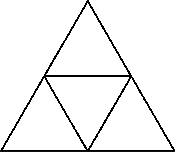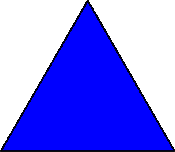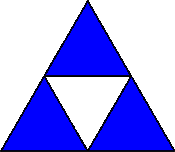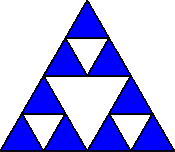Fractal Dimension - Sierpinski Gasket
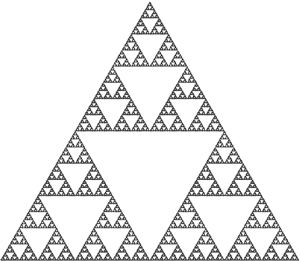 Determining the capacity dimension of the Sierpinski gasket is a good starting
point because we can easily retrieve the appropriate values for P and S in
our formula by examining the fractal image after a few iterations. This image
is shown on the left. Observe that it is a triangle, and consists of three
smaller triangles with a triangular space between them. These three triangles
are identical copies of the entire fractal, so we decide that our value for P will
be 3. Now what is the scaling factor? Observation also easily tells us that
the edge of the smaller triangles is half the edge of the fractal itself. Thus
our scaling factor S is 2. Applying these to our formula, we get:
Determining the capacity dimension of the Sierpinski gasket is a good starting
point because we can easily retrieve the appropriate values for P and S in
our formula by examining the fractal image after a few iterations. This image
is shown on the left. Observe that it is a triangle, and consists of three
smaller triangles with a triangular space between them. These three triangles
are identical copies of the entire fractal, so we decide that our value for P will
be 3. Now what is the scaling factor? Observation also easily tells us that
the edge of the smaller triangles is half the edge of the fractal itself. Thus
our scaling factor S is 2. Applying these to our formula, we get:

We came to this result incredibly easily. Note that we have
arrived at an irrational result for the gasket's dimension, which conceptually
is hard to fathom. However we should not be surprised that many values will
produce a non-integral capacity dimension, since our formula involves the ratio
of two logarithms.
The key to the ease with which we came up with our P and S values
is that the gasket is infinitely complex. The fractal is made up of three exact
copies of itself, and thus each of the three smaller triangles is constituted
of three smaller gaskets, and so on. If we simply draw three filled equilateral
triangles, and stack them in the same way to produce a larger equilateral
triangle as shown below, we cannot conclude that the larger triangle has
the same dimension as the Sierpinski gasket, because the smaller triangles
are definitely not
exact copies of the larger one. This figure is actually the second iteration
of the gasket, when certain Lindenmayer grammars are used to describe it. The
fractal itself is the limit as the number of iterations approaches
infinity.
|
Our capacity dimension formula does not apply
to this figure because it is not self-similar. |
Note that our value for d is between 1 and 2. From this
arises one argument for the validity of the formula for capacity dimension.
We observe that because the gasket is infinitely complex, the limit of its
length is infinite (a short proof is given below). However, because the gasket
is just a line after all (the white area is not part of the gasket),
it has zero area. An infinite length suggests a dimension greater than 1, but
an area
of
zero
suggests a
dimension less than 2, and our result agrees with this. Furthermore, our value
for d suggests
that the Sierpinski gasket is a little "closer" to being 2-dimensional
than it is
to
being 1-dimensional.
Proof of Infinite Length
|
|
|
|
|
|
n = 0
Smallest triangles: 1
Initial line length is 1.
|
|
n = 1
Smallest triangles: 3
1 triangle is split into 3 by drawing 3 lines of length 1/2.
|
|
n = 2
Smallest triangles: 9
3 triangles are split into 9 by drawing 9 lines of length 1/4.
|
We let n be the number of iterations performed so far,
with n = 0 for the first iteration. Observe the first three iterations
illustrated above. The first iteration consists of 1 triangle. This is then
split into 3 smaller triangles
(the centre
one
doesn't
count). Each of these 3 is then split to produce 9 triangles. If we only consider
the
smallest
triangles,
at each iteration n there are 3^n of them. These smallest triangles
are split into 3 triangles by inscribing three lines inside each: between the
midpoints of the edges. These inscribed lines are each 1/2 the length of the
triangle
being split. If
the
length
of the
first triangle's
edges is 1, then at n = 1 the inscribed edges have length 1/2 and
at n = 2 they have length 1/4, and at iteration n they have
length (1/2)^n. So at iteration n, the 3^(n-1)
smallest triangles from the previous iteration are split by
inscribing 3 edges with length (1/2)^n. Thus at iteration n the
length is increased by 3^(n-1)*3*(1/2)^n = (3/2)^n. At n = 0 the length
is 3, thus
we achieve the formula for the length of the Sierpinski gasket
as an infinite
sum:

Since the terms in the summation increase as i increases,
the sum is divergent and thus the length of the Sierpinski gasket is infinite.
QED
 Determining the capacity dimension of the Sierpinski gasket is a good starting
point because we can easily retrieve the appropriate values for P and S in
our formula by examining the fractal image after a few iterations. This image
is shown on the left. Observe that it is a triangle, and consists of three
smaller triangles with a triangular space between them. These three triangles
are identical copies of the entire fractal, so we decide that our value for P will
be 3. Now what is the scaling factor? Observation also easily tells us that
the edge of the smaller triangles is half the edge of the fractal itself. Thus
our scaling factor S is 2. Applying these to our formula, we get:
Determining the capacity dimension of the Sierpinski gasket is a good starting
point because we can easily retrieve the appropriate values for P and S in
our formula by examining the fractal image after a few iterations. This image
is shown on the left. Observe that it is a triangle, and consists of three
smaller triangles with a triangular space between them. These three triangles
are identical copies of the entire fractal, so we decide that our value for P will
be 3. Now what is the scaling factor? Observation also easily tells us that
the edge of the smaller triangles is half the edge of the fractal itself. Thus
our scaling factor S is 2. Applying these to our formula, we get:
